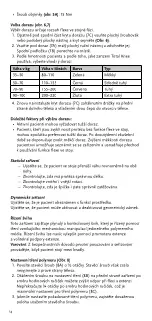
7
1. Fully engage the threads of the selected proximal adapter.
Caution:
Adapters from other manufacturers may not fully engage all
the threads and compromise the strength of the prosthesis.
2. Align the Pinch Bolt (1E) of the Male Pyramid Adapter (1D), 4-Prong
Socket Adapter (1A), and the Euro 4-hole Adapter (1C) perpendicular
to the anterior/posterior axis of the device, except for the Female
Pyramid Adapter (1B), which should be angled 45°.
Caution:
Maximum connection strength will not be established unless
the adapter is correctly aligned.
3. For secure fastening to the device, tighten the adapter’s Pinch Bolt
according to its instructions for use.
Caution:
Do not tighten the proximal adapter against the housing of
the device.
Caution:
When prong adapters are used, resin may get under the adapter
and hinder full thread engagement. Carefully remove resin without
damaging the adapter so that adapter threads can be fully engaged when
mounted on the device.
Caution:
Contact between socket/adapter and proximal 2/3 portion of the
device’s back link must be avoided when fully flexing the knee
(Fig. 2)
.
Contact in this area can damage the device. Acceptable contact is
between the socket and the distal 1/3 portion of the device’s back link.
ALIGNMENT INSTRUCTIONS
Bench Alignment (Fig. 3)
Alignment Goal
Alignment reference line (B) should:
– pass through midpoint of socket at the ischial tuberosity level (D)
– pass through pivot axis (A)
– fall at the 1/3 mark on the inside of the foot cover.
Note:
Prioritize knee alignment over foot alignment if there is a mismatch.
Alignment Instructions
1. Position the foot so that the alignment reference line (B) falls at the
1/3 mark on the inside of the foot cover (with the foot cover and shoe
on). Consider the external rotation of the foot.
2. Use the applicable adapters to connect the knee to the foot and
establish the correct knee center height.
3. Position the knee so that the alignment reference line passes through
pivot axis (A)
4. On the lateral side of the socket, make a first mark at the midpoint of
the socket at the ischial tuberosity level (D). Make a second mark at
the midpoint of the socket distally (E). Draw a line through both
marks.
5. Position the socket so the alignment reference line (B) goes through
first mark at the midpoint of the socket at the ischial tuberosity level (D).
6. Adjust the socket flexion to 5° in addition to the existing position
(i. e., hip flexion contracture) and set the height of the full prosthesis.
7. Use the applicable adapters to connect the knee to the socket.
Warning:
After adjustments, all screws must be secured with a medium
strength threadlocker and tightened with the correct torque.
Caution:
Adapters used on the distal connection must be cut straight and
inserted down to the end stop of the device's tube receiver. No spacer
should be used
(Fig. 4)
.
Summary of Contents for TOTAL KNEE 1900
Page 1: ...Instructions for Use TOTAL KNEE 1900...
Page 3: ...3 B D E C A 1 2 3 A 4 5 B D C E A 5 6 A B D C 7...
Page 4: ...4 I A B C E G F H D B A C A B C A 8 9 10 11...
Page 45: ...45 7A 7D 100...
Page 48: ...48 8 1 8A 2 8 8C 3 2 Nm 17 in lbs 7B 7A 0 38 0 76...
Page 49: ...49 7D 9 1 A B C 2 D E 3 4 F G 5 H 6...
Page 50: ...50 7 E H 8 15 50 6 10A 11 12...
Page 51: ...51 ssur 11A 11B 11C 12 12B ssur ISO 10328 3 5 ISO 10328 P5 100 kg...






















